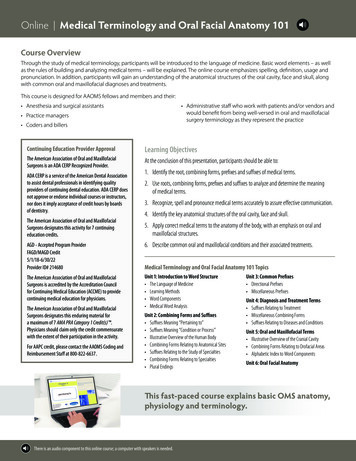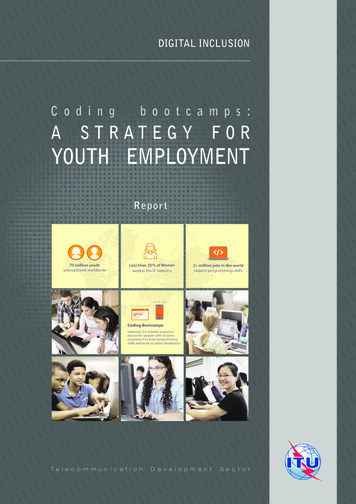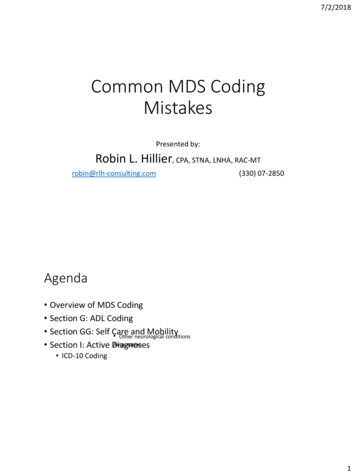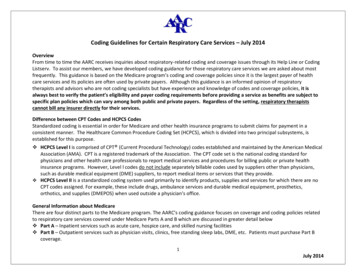
Transcription
De-coding T260-final.qxd2/10/20062:29 PMPage 1
De-coding T260-final.qxd2/10/20062:29 PMPage 2
De-coding T260-final.qxd2/10/20062:29 PMPage 3Our Sunday Visitor Publishing DivisionOur Sunday Visitor, Inc.Huntington, Indiana 46750
De-coding T260-final.qxd2/10/20062:29 PMPage 4The Scripture citations used in this work are taken from the CatholicEdition of the Revised Standard Version of the Bible (RSV), copyright 1965 and 1966 by the Division of Christian Education of theNational Council of the Churches of Christ in the United States ofAmerica. Used by permission. All rights reserved.Every reasonable effort has been made to determine copyrightholders of excerpted materials and to secure permissions as needed.If any copyrighted materials have been inadvertently used in this workwithout proper credit being given in one form or another, pleasenotify Our Sunday Visitor in writing so that future printingsof this work may be corrected accordingly.Copyright 2006 by Our Sunday Visitor Publishing Division,Our Sunday Visitor, Inc. Published 200611 10 09 08 07 06 1 2 3 4 5 6 7 8 9All rights reserved. With the exception of short excerpts for criticalreviews, no part of this work may be reproduced or transmitted in anyform or by any means whatsoever without permission in writing fromthe publisher. Write:Our Sunday Visitor Publishing DivisionOur Sunday Visitor, Inc.200 Noll PlazaHuntington, IN 46750ISBN-13: 978-1-59276-209-5ISBN-10: 1-59276-209-3 (Inventory No. T260)LCCN: 2006920100Cover design by Monica HanelineCover art: The Granger Collection, New York; “The Magdalene,”Bernardino Luini; oil on wood, c. 1525Interior design by Sherri L. HoffmanPRINTED IN THE UNITED STATES OF AMERICA
De-coding T260-final.qxd2/10/20062:29 PMPage 5 Dic nobis, Maria,quid vidisti in via?“VICTIMAE PASCHALI LAUDES,” ELEVENTH CENTURY
De-coding T260-final.qxd2/10/20062:29 PMPage 6
De-coding T260-final.qxd2/10/20062:29 PMPage 7TABLE OF CONTENTSIntroduction9One: Mary of Magdala15Two: ‘Why Are You Weeping?’23Three: The Real Mary?30Four: Apostle to the Apostles44Five: Which Mary?50Six: ‘The Golden Legend’58Seven: Touching the Magdalene72Eight: To the East79Nine: The Penitent87Ten: Mary and the Mystics96Eleven: The Magdalene in Art105Twelve: Rediscovery114Epilogue123For Further Reading127Appendix A: Mary Magdalene in the Gospels129Appendix B: ‘Gospel of Mary’137
De-coding T260-final.qxd2/10/20062:29 PMPage 8
De-coding T260-final.qxd2/10/20062:29 PMPage 9INTRODUCTIONEqual-to-the-Apostles.Blessed Sinner.Spouse of Jesus. . . Goddess?he resume is impressive, if ultimately fanciful, but it actually onlybegins to touch on the many ways in which Mary Magdalenehas been interpreted over the past two thousand years. Legends,myths, and wish fulfillment abound, but what’s the truth — basedon the evidence of history — about Mary Magdalene?Mary Magdalene was an enormously important figure in earlyChristianity. She was, after the Blessed Virgin Mary, the mostpopular saint of the Middle Ages. Her cultus reveals much aboutmedieval views of women, sexuality, sin, and repentance. Today,Mary Magdalene is experiencing a renaissance, not so much fromwithin institutional Christianity, but among people, mostly women,some Christian, many not, who have adopted her as an inspiration and patron of their own spiritual fads, paths, and fantasies.TMary Magdalene is the patron saint of contemplatives, converts,pharmacists, glove makers, hairdressers, penitent sinners, perfumers, sexual temptation, and women.This book is a very basic introduction to the facts and the fiction surrounding Mary Magdalene. We’ll unpack what Scripturehas to say about her identity and role in apostolic Christianity.We’ll see how, very soon after that apostolic era, she was adoptedby a movement that remade her image in support of its owntheological agenda, a dynamic we see uncannily and, without irony,repeated today.9
De-coding T260-final.qxd102/10/2006DE-CODING2:29 PMPage 10MARY MAGDALENEWe’ll look at the ways in which both Western and EasternChristianity have described, honored, and been inspired by her, andhow their stories about her have diverged. During the MiddleAges in the West, Mary Magdalene’s story functioned most of allas a way to teach Christians about sin and forgiveness: how to bepenitent, and with the hope of redemption open to all. She madefrequent appearances in religious art, writing, and drama. Sheinspired many to help women and girls who had turned to prostitution or were simply destitute. She inspired Franciscans andDominicans in their efforts to preach reform and repentance.It all sounds very positive, and most of it, indeed, is. That’s not,however, the idea we get from some contemporary commentatorson Mary Magdalene’s historical image.Many of you might have had your interest in the Magdalenepiqued by the novel The Da Vinci Code, by Dan Brown. In that novel,Brown, picking up on strains bubbling through pop culture andpseudo-historical writings of the past fifteen years or so, presents acompletely different Mary Magdalene than the woman we meet inthe Gospels and traditional Christian piety. She was, according toBrown, Jesus’ real choice to lead his movement; a herald of Jesus’ message of the unity of the masculine and feminine aspects of reality; avaliant and revered leader opposed by another faction of Jesus’ apostles led by Peter; the mother of Jesus’ child; and in the end, some sortof divine figure herself. Mary Magdalene is no less than the HolyGrail herself, bearing the “blood” of Jesus in the form of his child.A glorious figure, indeed, was this Mary Magdalene, but onethat a patriarchal church could not permit to flourish. So, the storygoes, a new image of Mary was created: that of the penitent prostitute. This Mary Magdalene, degraded and demeaned, was thetool of a conspiracy to degrade and demean women in general, andto bury the “truth” of Mary Magdalene’s leadership in early Christianity once and for all.The theory fails on a couple of levels. First, there’s no evidenceto support it. That would seem like a fairly daunting obstacle.
De-coding T260-final.qxd2/10/20062:29 PMPage 11Introduction11There were certainly other interpretations of Jesus aside from theorthodox, apostolic experience and witness to him. We generallycall these “heresies.” Mary Magdalene was used, in minor ways, bysome of these groups to embody their teachings, but — and thisis the important point — these groups’ writings date from at least twocenturies after the life of Jesus and have no connection to the events ofthat period. The Mary-Peter competition is a myth and a misuseof these writings, which do have historical value — but for whatthey tell us about third- and fourth-century Gnosticism, not theJesus movement of the first century.The heresy that some modern thinkers believe says the mostabout Mary Magdalene is Gnosticism. Gnosticism was a diffusesystem of thought that taught, in general, that the materialworld was evil, and that salvation came from freeing the spiritimprisoned within the body. Christian Gnostics saw Jesus as aGnostic teacher, and some Gnostic systems presented Mary asone of his wisest students.The image of Mary Magdalene as repentant sinner certainly isa medieval development, but as we shall see, it is the consequence,not of a political plot, but of a not-entirely illogical conflation ofMary with other figures in the Gospels.The logic of the conspiracy theorists is flawed, too. If the patriarchy sought to demean the Magdalene, they did a terrible job ofit, for it is difficult to see a figure who inspired prayer, devotion,countless good works, and who was honored and celebrated as asaint, and who was even popularly depicted in art as preaching, asa demeaned, degraded creature. Those who espouse these theoriesdemonstrate, every time they write a sentence, an appalling, butnot surprising, ignorance of historical and cultural context.Brown’s plot is a simplified version of some pretty complicatedand esoteric theories about Mary Magdalene, a genre of spiritual
De-coding T260-final.qxd122/10/2006DE-CODING2:29 PMPage 12MARY MAGDALENEspeculation probably most strongly personified by Margaret Starbird, author of The Woman with the Alabaster Jar: Mary Magdaleneand the Holy Grail and Mary Magdalene, Bride in Exile.Be assured that this kind of theorizing is not taken seriouslyby any scholars, no matter how secular or hostile to traditionalChristianity those scholars might be. In my speaking on The DaVinci Code, I often run into people who hold on to that novel, aswell as its inspiration, Holy Blood, Holy Grail, The Templar Revelation, and Starbird’s work, as serious exercises in history. They arenot. A simple test to administer, if you doubt me, is as follows. Arethese works used in courses on the History of Christianity at anyuniversity of any stripe, secular or religious? The answer: No.In my research for this book, I have read much of the contemporary historical scholarship on Mary Magdalene. The onlytimes the theories of Brown, Starbird, and their ilk are mentionedare in bemused footnotes on popular culture. The major work onthe history of the Holy Grail written in the past few years, The HolyGrail: Imagination and Belief, published by Harvard UniversityPress, does not mention Mary Magdalene in 370 pages of text.Are they all part of the conspiracy, too?The Magdalene-Spouse-Queen-Goddess-Holy-Grail theoriesare not serious history, so, frankly, we are not going to bother withthem until the final chapter, and then only briefly. What we willbe looking at — the history of the person and the imagery of MaryMagdalene — is daunting, rich, and fascinating enough.The contemporary scholarship on Mary (and, indeed, on muchof the history of Christian spirituality and religious practices) isgrowing so fast and is so rich that all I can do here is simply provide an introduction. A thorough, objective introduction, I hope,but the fact is that the burgeoning scholarship on Mary Magdalene is quite vast, and much of it, particularly that dealing with themedieval period, is not yet available in English. I have provided anannotated bibliography at the end of this book for those readersinterested in pursuing this subject in more depth.
De-coding T260-final.qxd2/10/20062:29 PMPage 13Introduction13Our brief survey will undoubtedly be revealing, as we rediscoverhow deeply Mary Magdalene has been revered, used, and yes, misused and misunderstood by Christians over the centuries. Thestory, I hope, will be provocative in the best sense. For the fact is,the greatest interest in Mary Magdalene in the West today comesfrom those outside of or only nominally attached to the greatcourse of traditional apostolic Christianity. Roman Catholics, inparticular, seem to have lost interest in her, as, it must be admitted, they have in most saints.Lots of people are listening to a Magdalene of their own making, a figure with only the most tentative connection to the St.Mary Magdalene of centuries of traditional Christian witness.May the story recounted in the book play a part in reclaimingMary Magdalene, so that we may hear her speak clearly again, asshe does in the Gospels: for Jesus Christ, her Risen Lord.A NOTE ON TERMS Orthodox, when capitalized, refers to the Eastern OrthodoxChurches.When not capitalized,“orthodox” refers to Christianity that is self-consciously rooted in Scripture, apostolicteaching, and the tradition of the Early Church. Cultus, or “cult,” when used in references to saints, does nothave a derogatory connotation. It is a term used for the devotional practices that build up around a particular saint.
De-coding T260-final.qxd2/10/20062:29 PMPage 14
De-coding T260-final.qxd2/10/20062:29 PMPage 15OneMARY OF MAGDALAefore the legends, myths, and speculation, and even before thebest-selling novels, there was something else: the Gospels.The figure of Mary Magdalene has inspired a wealth of art,devotion, and charitable works throughout Christian history, butif we want to really understand her, we have to open the Gospels,because all we really know for sure is right there.The evidence seems, at first glance, frustratingly slim: an introduction in Luke, and then Mary’s presence at the cross and at theempty tomb mentioned in all four Gospels. Not much to go on,it seems.But in the context, the situation isn’t as bad as it appears. Afterall, no one besides Jesus is described in any detail in the Gospels,and even the portrait of Jesus, as evocative as it is, omits detailsthat we moderns are programmed to think are important. Perhaps, given the context, the Gospels tell us more about Mary Magdalene than we think.BTrustworthy?Before we actually meet the Mary Magdalene of the Gospels, itmight be a good idea to remind ourselves of exactly what theGospels are and how to read them.The word “Gospel” means, of course, “good news,” or evangelin Greek, which is why we call the writers of the Gospels evangelists. The four Gospels in the New Testament have been acceptedas the most authoritative and accurate writings on Jesus’ life sincethe early second century. Even today, scholars who study earlyChristianity, whether they are believers or not, know that when15
De-coding T260-final.qxd162/10/2006DE-CODING2:29 PMPage 16MARY MAGDALENEstudying Jesus and the early Christian movement, the Gospels andother New Testament writings are the place to begin.Sometimes in my speaking on this issue, I have fielded questions about the reliability of the Gospels. A questioner will saysomething like, “Well, they were written so long after the events,how can we trust them to tell the truth?”In addition, even those of us who have received some sort of religious education might have been taught, implicitly, to be skepticalof the Gospels. We’re reminded, right off, that the Gospels are nothistory or biography, and that they tell us far more about the community that produced them than about Jesus himself.In short, all of this gets distilled into the conviction that whenit comes to early Christianity, all documents and texts are of equalvalue in telling us about Jesus. You can’t pick the best according tohistorical reliability, so you pick the one with the “story” that meansthe most to you. So, if the Gospel of Mark displeases you, you cango ahead and create your Jesus from what you read in the Gospelof Philip or the Pistis Sophia.Sorry, but it just doesn’t work that way. As we will see in moredetail when we get to the Gnostic writings, there is simply nocomparison between the four canonical Gospels and other writings. The canonical Gospels were not written that distant from theevents described — forty or fifty years — and were written in anoral culture that took great care to preserve what it heard with care;the community’s history depended on it. When you actually readthe Gospels, you see comments here and there from the evangelists themselves about what they were trying to do, and part of thatinvolved, according to their own admission, being as accurate aspossible (see Luke 1:1-4, for example).No, the Gospels are not straight history or biography in thecontemporary sense. They are testaments of faith. But they aretestaments of faith rooted in what really happened. The evangelists,and by extension, the early Christians, were not about making upstories for which they would later, oddly, give their lives. They
De-coding T260-final.qxd2/10/20062:29 PMPage 17Mary of Magdala17were not cleverly presenting their inner psychological transformations in the form of concrete stories. They were witnesses to theamazing action of God in history, through Jesus. They are testimonies of faith, yes, but faith rooted in the realities of God’s movement in the world.It’s also good to listen to Gospel critics carefully. More oftenthan not, those who disdain the Gospels are quick to claim someother text as “gospel,” as the source of truth. Their choice of whatto believe usually has far less to do with historical reliability thanit does with other factors.So, no, not all historical texts are equally reliable. When itcomes to Jesus and the events of the mid-first century, the canonical Gospels are really the only place to begin.Now, on to Mary Magdalene.MagdalaLuke introduces us to Mary Magdalene in chapter 8 of his Gospel:“Soon afterward he went on through cities and villages, preaching and bringing the good news of the kingdom of God. And thetwelve were with him, and also some women who had beenhealed of evil spirits and infirmities: Mary, called Magdalene,from whom seven demons had gone out, and Joanna, the wife ofChuza, Herod’s steward, and Susanna, and many others, whoprovided for them out of their means.” (Luke 8:1-3)So here she is: a woman from whom Jesus had driven sevendemons, joined with other women, also healed by Jesus, who hadleft their lives behind to follow him.Mary is mentioned first in this list, as she is in every list offemale disciples, in every Gospel, similar to the way that in lists ofthe twelve apostles Peter’s name always comes first. The precisereason for Mary’s consistent preeminence is impossible to deter-
De-coding T260-final.qxd182/10/2006DE-CODING2:29 PMPage 18MARY MAGDALENEmine, but we can guess that it might have much to do with herimportant role related to the Resurrection, as well as to recognition of her faithfulness to Jesus.These women “provided for them out of their means.” Thismight mean one of two things, or both: that the women assistedJesus and his disciples by preparing meals and so on, or that theysupported them financially. The second explanation is supportedby the presence of Joanna, the wife of a member of Herod’s court,on the list. Perhaps some of these women were, indeed, wealthyenough to give Jesus’ ministry a financial base. (Some legendsabout Mary have played off of this, as we will see later, suggestingthat she was quite wealthy and actually owned the town ofMagdala.)What stands out about Mary is that she’s identified, not by herrelationship to a man, as most women would be at that time, butto a town. This indicates that Mary wasn’t married, and perhapseven that she had outlived her father and other male relatives: shewas a single woman, able to give support to Jesus out of gratitudefor what he had done for her.Magdala was located on the western shore of the Sea of Galilee,about four miles north of the major city of Tiberias. Today, it is avillage with a few hundred inhabitants, some abandoned archaeological digs, and only the most inconspicuous memorials to itsmost well-known inhabitant.“Magdala” is derived from the Hebrew Migdal, which means“fortress” or “tower.” It was also called “Tarichea,” which means“salted fish,” a name which reveals the town’s primary industryduring the first century, the salting and pickling of fish. Excavations led by Franciscans in the 1970s revealed a structure that somethink was a synagogue (others a springhouse), as well as a coupleof large villas and, from later centuries, what might be a Byzantine monastery. Magdala is described by Josephus, a first-centuryJewish historian, as having forty thousand inhabitants, six thousand of whom were killed in one of the battles during the Jewish
De-coding T260-final.qxd2/10/20062:29 PMMary of MagdalaPage 1919Revolt (A.D. 66-70), but most modern historians believe thosenumbers are far too high.Jewish tradition suggests that Magdala was ultimatelydestroyed as a punishment for prostitution, and another strainholds that in ancient times Job’s daughters died there. Pilgrimaccounts from the ninth through the thirteenth centuries reportthe existence of a church in Magdala, supposedly built in the fourthcentury by St. Helena, who discovered the True Cross in Jerusalem.By the seventeenth century, pilgrims reported nothing but ruinsat Magdala.PossessedMary — like Peter, Andrew, and the other apostles — walkedaway from life as she knew it, abandoned everything to followJesus. Why?“. . . from whom seven demons had gone out.”Exorcism is an aspect of Jesus’ ministry that many of us eitherforget about or ignore, but the Gospels make clear how importantit is: Mark, in fact, describes an exorcism as Jesus’ first mightydeed, in the midst of his preaching (1:25). Some modern commentators might declare that what the ancients referred to as possession was nothing more than mental illness, but there is reallyno reason to assume that is true. The “demons,” or unclean or evilspirits, we see mentioned sixty-three times in the Gospels wereunderstood as forces that indeed possessed people, inhabitingthem, bringing on what we would describe as mental problems,emotional disturbances, and even physical illness. The symptoms,however, were, to the ancient mind, only that: symptoms. Thedeeper problem was the alienation from the rest of the humanfamily and from God produced by this mysterious force of evil.In the world in which Jesus lived, seven was a number that symbolized completion, from the seven days of creation (Genesis 1:12:3) to the seven seals on God’s book in Revelation (5:1) and theseven horns and eyes of the Lamb in the same vision (5:6). Mary’s
De-coding T260-final.qxd202/10/2006DE-CODING2:29 PMPage 20MARY MAGDALENEpossession by seven demons (also explicitly mentioned in Mark16:9) indicates to us that her possession was serious and overwhelming — total, in fact. She was wholly in the grip of these evilspirits, and Jesus freed her — totally.So of course, she left everything and followed him.It’s worth noting now, even though we’ll discuss it more later,that nowhere in the New Testament is the condition of possessionsynonymous with sinfulness. The “sinners” in the Gospels — thetax collectors, those who cannot or will not observe the Law, theprostitutes — are clearly distinguished from those possessed. SomeChristian thinkers have linked Mary Magdalene to various sinful,unnamed women in the Gospels because of her identification asformerly possessed. There may be reasons, indeed, to link Mary tothese women, but possession is not one of them, because the conditions — possession and sinfulness — are not the same thing inthe minds of the evangelists.DiscipleThe evangelists used the texts, memories, and oral traditions theyhad at hand to communicate the Good News about Jesus. Becausethey were human beings, their writing and editing bears the stampof their unique concerns and interests. Just as you and a spousemight tell the same story, emphasizing different aspects of it tomake different points — perhaps you want to tell the story of yourmissed flight as a warning about being organized and prepared,and he wants to tell it as a way to highlight the need to go withthe flow — the evangelists shaped the fundamental story of Jesusin accord with what struck them as the most significant points ofhis life and ministry, what their audiences most needed to hear.In the eighth chapter of his Gospel, Luke has finished introducing Jesus, and is ready to really help his audience understandwhat being a disciple means. He begins by describing who is following Jesus — the Twelve and the women — and then offers ageneral description of what Jesus’ ministry is about. Jesus then tells
De-coding T260-final.qxd2/10/20062:29 PMPage 21Mary of Magdala21his first parable (the parable of the sower and the seeds, which isthe first parable Jesus relates in all of the Gospels), then quicklycalms a storm, performs another dramatic exorcism, raises a littlegirl back to life, and in the midst of it tells his followers, firmly,that his blood relations are not his family, but rather those who“hear the word of God and do it” (Luke 8:21).So that’s the context of the introduction of Mary Magdaleneand the other women — not just to set the stage, to complete thecast of characters, because Luke, like all of the other evangelists,didn’t have vellum to spare to do such a thing. Every word hewrote had a purpose, and it was very focused — here, to set beforeus, in quick, strong strokes, what this kingdom of God was allabout. What do we learn from the presence of the women?First, we learn that women are present, period. Women werenot chattel slaves in first-century Judaism, by any means, but neither were they often, if ever, seen leaving their ordinary lives to follow a rabbi. In fact, scholar Ben Witherington describes thisconduct as “scandalous” in the cultural context (Women in the Ministry of Jesus [Cambridge University Press, 1984]):“We know women were allowed to hear the word of God in thesynagogue but they were never disciples of a rabbi unless theirhusband or master was a rabbi willing to teach them.Though awoman might be taught certain negative precepts of the Lawout of necessity, this did not mean they would be taught rabbinicexplanations of Torah. For a Jewish woman to leave home andtravel with a rabbi was not only unheard of, it was scandalous.Even more scandalous was the fact that women, bothrespectable and not, were among Jesus’ traveling companions.”(Witherington, p. 117)And not just any women, either. As we noted earlier, MaryMagdalene was once possessed by seven demons. In this culture,
De-coding T260-final.qxd222/10/2006DE-CODING2:29 PMPage 22MARY MAGDALENEthose possessed were ostracized — one man Jesus exorcised isdescribed as living in a cemetery (Luke 8:27). Mary Magdalene,formerly at the margins of society, has been transformed by Jesusand is now welcomed as a disciple. The barriers of class, too, arebroken, Luke hints, with the presence of Joanna, the wife of a person of stature. In God’s kingdom, Luke makes clear, the world weknow is being turned upside down.Just as every phrase and scene in the Gospels is carefully chosen under the inspiration of the Holy Spirit, so are the parts of theGospel related. We meet Mary Magdalene here, but we will notsee her again for many chapters — until the Passion narrativebegins. But when we do encounter her — again, with the otherwomen — here’s what she will be doing: she will be standing nearthe cross, she will then be preparing Jesus’ body for burial, and latershe will see and witness to the empty tomb, and encounter the risenJesus.Mary will be serving, still. She serves, watches, and waits, theonly remaining link between Jesus’ Galilean ministry, his Passion,and the Resurrection. She is introduced as a grateful, faithful disciple, and that she will remain, a witness to the life Jesus brings.Already, there’s a sort of mystery: what were these demons? Whatexactly happened to Mary? The evangelists don’t tell us, perhapsbecause they and Mary herself knew that life with Jesus is notabout looking back into the past, but rather rejoicing in God’spower to transform our lives in the present.Questions for Reflection1. What do we know about Mary Magdalene’s life from theGospels?2. What does her presence in Jesus’ ministry tell you about thekingdom of God that Jesus preached?3. How has God acted in your life with power? How do yourespond to that? How would you like to respond?
De-coding T260-final.qxd2/10/20062:29 PMPage 23Two‘WHY ARE YOU WEEPING?’uke is the only evangelist to mention Mary Magdalene beforethe Passion narratives, but once those events are set in motion,Mary is a constant presence in all of the Gospels, without exception. For the first few centuries of Christian life, it is her role inthese narratives that inspired the most interest and produced theearliest ways of describing Mary Magdalene: “Myrrh-bearer” and“Equal-to-the-Apostles.”LAt the CrossIn both Matthew (27:55) and Mark (15:40-41), Mary Magdaleneis named, first in the list of women watching Jesus’ execution.Luke doesn’t name the women at the cross, but he does identifythem as those who had “followed him from Galilee.” John alsomentions her presence (19:25), but his account highlights thepresence of Mary, the mother of Jesus, and Jesus’ words commending her to John’s care.After Jesus’ body is taken down from the cross, Mary and theother women are still there. Matthew (27:61) and Mark (15:47)both specifically mention her as seeing where Jesus’ body was laid,and Luke again refers to the “women . . . from Galilee” (23:55),whose identity we are expected to understand from Luke’s earlymention of their names in chapter 8.“Love is as strong as death.This was seen in the Lord’s passion,when Mary’s love did not die.” (The Life of St. Mary Magdalene and ofHer Sister St. Martha, by Rabanus Maurus (translated and annotated by DavidMycoff) [Cistercian Publications, 1989], p. 61)23
De-coding T260-final.qxd242/10/2006DE-CODING2:29 PMPage 24MARY MAGDALENEFinally, as the Sabbath passes and the first day of the weekdawns, the women still remain, and the Twelve are still nowherein sight. Matthew describes Mary Magdalene and “the otherMary” (not the mother of Jesus, but probably the Mary, mother ofJames and Joseph, that he had mentioned in 27:56) coming to“see” the tomb. Mark and Luke get more specific, saying that thewomen have come to anoint Jesus’ body. John, interestinglyenough, in chapter 20, ignores any other women, and focuses onMary Magdalene. She comes to see the tomb, finds the stonemoved and the tomb empty, and runs to tell Peter.At least one early critic of Christianity seized on Mary Magdalene’s witness as discrediting. As quoted by the Christian writerOrigen, the second-century philosopher Celsus called her a “halffrantic woman” (Contra Celsus, Book II: 59), thereby calling intodoubt the truth of her testimony of the empty tomb.What is striking about John’s account is that even though Peterand others do indeed run to the tomb at Mary’s news and see itempty, that is all they see. They return, and after they have goneaway, Mary remains, alone at the tomb, weeping. It is at this pointthat, finally, the risen Jesus appears.Of course, Jesus appears to Mary and other women in the Synoptic Gospels as well. In Matthew (chapter 28), an angel first givesthem the news that Jesus has risen from the dead. The women thendepart to t
Mary Magdalene is experiencing a renaissance, not so much from within institutional Christianity,but among people,mostly women, some Christian, many not, who have adopted her as an inspira-tion and patron of their own spiritual fads, paths, and fantasies. Mary Magdalene is the patron saint of contemplatives,converts, pharmacists, glove makers .










